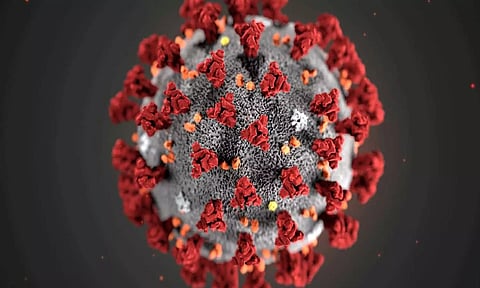

LONDON: In a first, researchers have demonstrated that different variants of SARS-CoV-2, the virus behind Covid-19, have the ability to infect the central nervous system.
The study, conducted in an animal model and published in the journal Nature Communications, confirms that SARS-CoV-2 is capable of infecting human neurons in vitro and migrating into axons -- the nerve cell projections that carry information.
In the study, researchers from the Institut Pasteur and Universite Paris Cite in France demonstrated that the original strain of the virus first detected in Wuhan and the Gamma, Delta and Omicron/BA.1 variants can enter the central nervous system and remain there during the acute phase of the infection.
The researchers observed that all these variants spread to the central nervous system and infect the olfactory bulb, a structure located in the cranial cavity that processes olfactory information before transmitting it to the cortex.
"In this study, we demonstrated that infection of the olfactory bulb is common to all variants and not linked to any particular one, nor to any particular clinical manifestation such as anosmia (loss of smell)," explained first author Guilherme Dias de Melo, researcher in the Institut Pasteur's Lyssavirus, Epidemiology and Neuropathology Unit.
Moreover, the researchers identified a genetic sequence linked to anosmia in the ancestral (Wuhan) virus.
When this genetic sequence, which encodes the ORF7ab protein, is deleted or truncated -- which is the case in certain variants less likely to produce anosmia -- the incidence of olfactory loss in infected animals is lower even though the degree of neuronal infection via the olfactory bulbs remains unchanged.
"This suggests that anosmia and neuronal infection are two unrelated phenomena," Dias de Melo said.
"If we follow this line of reasoning, it is quite possible that even an asymptomatic -- and therefore clinically benign -- infection is characterised by the spread of the virus in the nervous system."
The researchers then looked at how SARS-CoV-2 reached the olfactory bulb and observed that neurons appeared to be the ideal route.
An in vitro microfluidic cell culture system enabled the researchers to observe human neurons organised in a particular way. The neurons are arranged so as to allow detailed observation of the transport of molecules within the axon.
Using this method, the researchers found that, once inside the neuron, the virus is able to move in both directions along the axon, either in an anterograde direction, i.e. from the cell body to the axon terminals, or in a retrograde direction, from the axons to the cell body.
"The virus seems to effectively exploit the physiological mechanisms of the neuron to move in both directions. The SARS-CoV-2 variants we studied -- the ancestral Wuhan variant, Gamma, Delta and Omicron/BA.1 -- infect neurons in vitro and are capable of moving along axons," the researchers said.